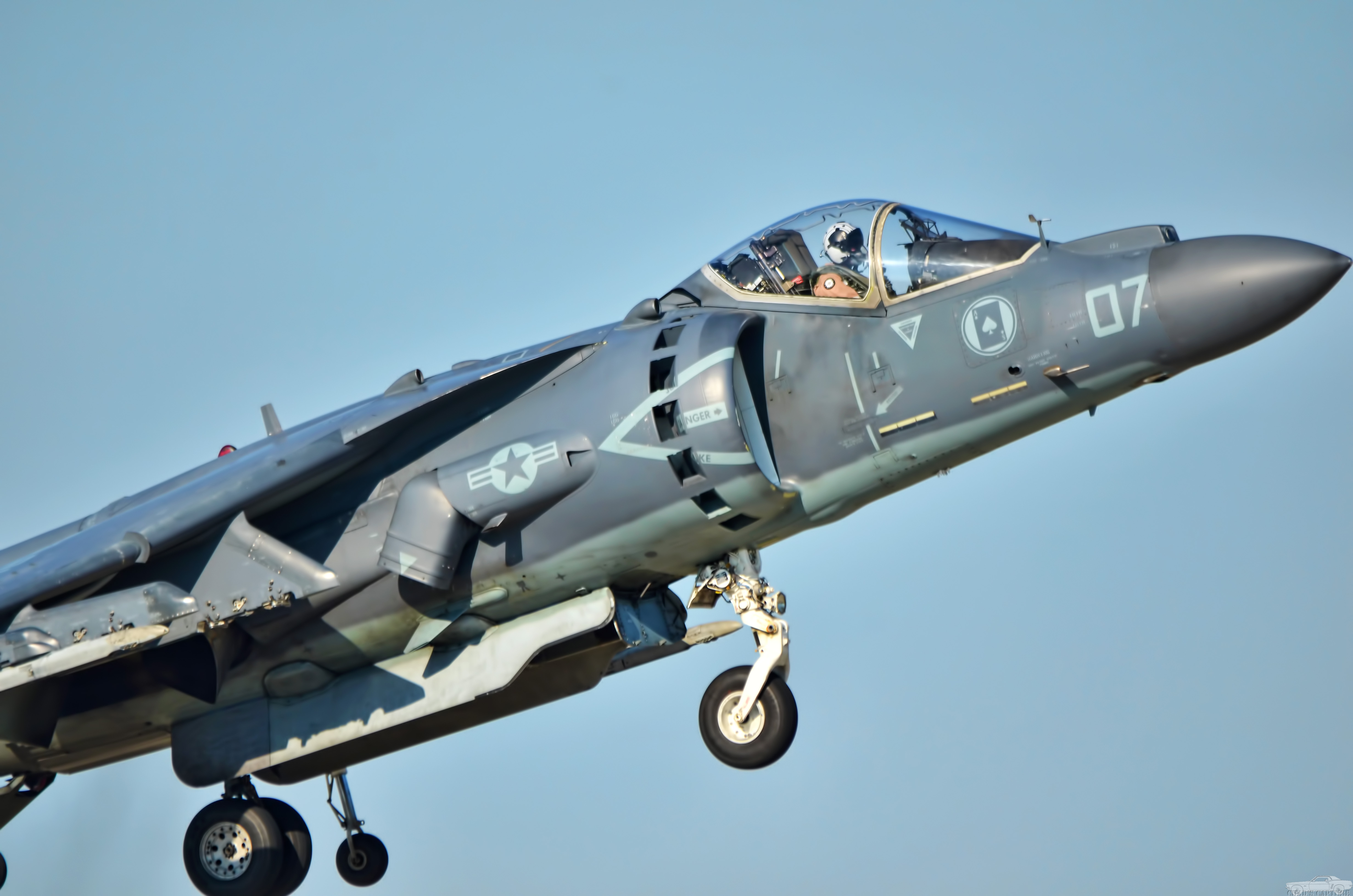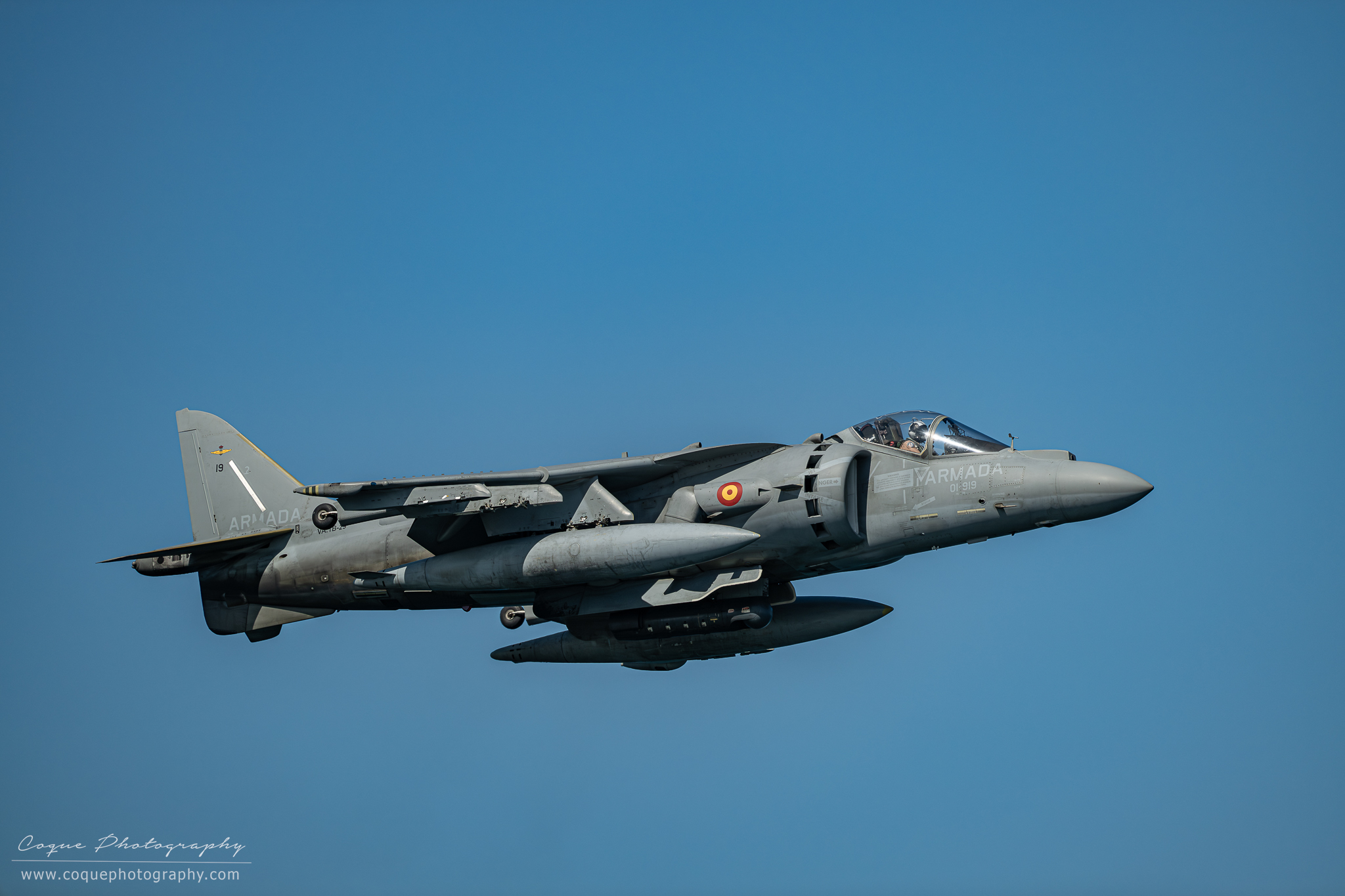The AV-8B Harrier II is a single-engine attack aircraft with vertical or short takeoff and landing (V/STOL) capability, representing the second generation of the Harrier family. This aircraft is primarily designed to provide close air support to ground forces and carry out armed reconnaissance missions. Its primary users include the United States Marine Corps (USMC), the Spanish Navy, and the Italian Navy.
Historical Background and Initial Prototypes
The AV-8 Harrier II represents a groundbreaking technological advancement in modern air warfare. It is an evolution of the Harrier series, the first fixed-wing aircraft to successfully achieve operational vertical takeoff and landing (VTOL) capabilities worldwide. Developed to address the shortcomings of the first model, the Hawker Siddeley Harrier of the 1960s, and to adapt to modern combat conditions, the AV-8 Harrier II stands out particularly for its ability to take off from ships with limited deck space.
The development process of the AV-8B Harrier II began in the early 1970s as a joint effort between the United States and the United Kingdom. Initial efforts focused on developing a larger and more powerful Pegasus engine to significantly enhance the Harrier's capabilities. However, due to budget constraints, the United Kingdom withdrew from the project in 1975.
Following the UK's withdrawal, McDonnell Douglas extensively redesigned the previous AV-8A Harrier to create the AV-8B. While preserving the overall structure of the earlier design, the aircraft incorporated a new and larger composite wing, an additional weapon station on each side, an upgraded cockpit, a redesigned fuselage, and other structural and aerodynamic improvements. The aircraft was powered by an improved Pegasus engine.
The AV-8B's maiden flight took place in November 1981, and it entered USMC service in January 1985. Subsequent upgrades included night attack capability and the addition of radar, leading to the development of the AV-8B (NA) and AV-8B Harrier II Plus versions. A larger version, the Harrier III, was considered but never realized. The UK rejoined the improved Harrier project in 1981 through British Aerospace, contributing significantly to the program.
During the Cold War, the Harrier II served as a critical deterrent for NATO, combining the technical expertise of the US and the UK to deliver versatility and effectiveness.

AV-8B Harrier II vertical landing (Source: YouTube.com)
Two YAV-8B prototypes were produced during the development of the AV-8B Harrier II. These prototypes were used for full-scale wind tunnel testing, flight trials, and structural verifications. Following the successful completion of these tests, the AV-8B Harrier II entered mass production. The first AV-8B squadron became operational in 1985.
Design Features
The AV-8B Harrier II's production involved multiple international contributors. British Aerospace developed the aircraft's aerodynamic design and structural components, while McDonnell Douglas focused on modular airframe design and integration with US standards. This collaboration enabled the aircraft to meet the diverse needs of both the UK and US armed forces.
The Harrier II's fuselage was extensively redesigned using composite materials to reduce weight and increase durability. Specifically, carbon-fiber-based composites replaced metal components, preventing corrosion and lowering maintenance costs. The use of composite materials reduced the overall weight by 25%.
The wing structure of the AV-8B was redesigned to enhance aerodynamic efficiency and weapon capacity. Larger and broader wings allowed the aircraft to carry more payload and perform better at low speeds. Additionally, the addition of one weapon station on each side increased the total ammunition capacity.

Underside view of AV-8B Harrier II (Photo: David Álvarez López, flickr.com)
The Pegasus engine, developed by Rolls-Royce, is central to the aircraft's vertical takeoff and landing capabilities. The engine's rotating nozzles enable both forward flight and vertical movement. The Pegasus 11 series engine produces higher thrust than the engines used in the earlier AV-8A Harrier.
The cockpit was redesigned to improve ergonomics and enhance the pilot’s situational awareness. The updated cabin offers a wide field of view and is equipped with night vision systems for nighttime operations. Approximately 337 Harrier IIs were produced, many of which remain actively used by the US Marine Corps.

AV-8B Harrier II technical drawing (Source: drawingdatabase.com)
Aerodynamic Design
The AV-8B Harrier II achieves its vertical takeoff and landing capability through an effective aerodynamic structure. The four-directional nozzles of the Pegasus engine provide the aircraft with versatility and efficient maneuverability. These nozzles direct airflow vertically, horizontally, or in combined directions. During takeoff, engine thrust is directed downward through the nozzles, generating vertical lift. During forward flight, the nozzles shift airflow horizontally to accelerate the aircraft. The same system supports control during landing, allowing the aircraft to land on a fixed point. Although the wings are shorter relative to the fuselage, they are specially optimized to ensure flight stability. With various weapons and fuel pods carried under its wings, the Harrier II is considered a versatile combat aircraft.

The engine power's vertical lift through nozzles (Source: YouTube.com)

Close-up view of AV-8B Harrier II nozzles (Photo: Chad Horwedel, flickr.com)
Combat, Achievements, and Missions
The AV-8B Harrier II has engaged in combat both over sea and in land-based operations. Its notable performance during the Falklands War served as a milestone, with improved models building upon this legacy. The Harrier II is equipped with AIM-9 Sidewinder missiles for countering aerial threats and systems like AGM-65 Maverick missiles and laser-guided bombs for striking ground targets, making it a formidable weapon platform.
The AV-8B Harrier II played a significant role in operations such as Operation Deliberate Force and Operation Desert Storm, providing close air support for ground forces. Its vertical takeoff and landing capabilities, along with its versatile weapon load, made it a preferred choice for various scenarios.

AV-8B Harrier II (Photo: Coque Photography, flickr.com)
Chronic Issues
Despite its robust design, the Harrier II faces several chronic issues. The complexity and maintenance costs of the Pegasus engine have been key factors affecting the aircraft’s operational efficiency. Additionally, its speed performance is relatively low due to this complexity. Excessive fuel consumption during vertical takeoff and landing maneuvers is another significant disadvantage, limiting the aircraft’s range in the field. The intense heat from the nozzles during vertical flight has also caused damage to runway equipment and surrounding environmental elements.
Pilot reports indicate stabilization issues at low speeds and in vertical flight mode. These challenges have particularly complicated emergency landing maneuvers. Furthermore, the aircraft's radar and avionics systems became outdated compared to emerging threats post-1990s.
Pilot Feedback
The AV-8B Harrier II has garnered admiration among its pilots while also being recognized as a demanding aircraft. Its maneuverability and vertical takeoff and landing capabilities have been described by many as "the flexibility of a helicopter with the power of a jet." However, the aircraft's complex flight controls posed challenges, especially for new pilots.
A Royal Air Force pilot John Nichol, highlighted the Harrier II's primary advantage: "The Harrier can take off not just from a runway but almost any flat surface. This capability provided us with tremendous flexibility in combat environments." 【1】 Nonetheless, fuel consumption and maintenance requirements were frequently criticized.
Flying Pilots' Battle Strategies
The Harrier II's battle strategies revolve around its vertical takeoff and landing capabilities. The aircraft was particularly utilized in frontline operations, gaining attention for its rapid response capability. Pilots preferred low-altitude flights to reduce the detection capabilities of enemy radar, leveraging the aircraft's maneuverability to gain an advantage.
The low runway requirements for takeoff and landing made the Harrier II an ideal platform for operations in rugged terrain. During Operation Desert Storm, the Harrier II was effectively deployed to provide close air support to ground forces. Pilots conducted precision strikes on enemy targets using laser-guided bombs and AGM-65 Maverick missiles.


